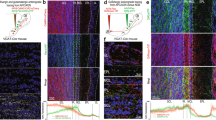Abstract
The concept that neurotransmitter released from a neurone may feed back and influence the excitability of the same neurone has been suggested by a variety of evidence. Anatomical studies have shown that axon collaterals can arborize among the dendrites of the parent neurone1–7, suggesting a direct feedback via axon collaterals. In addition, the dendritic release of dopamine from substantia nigra neurones has suggested that dopamine may exert a direct feedback inhibition of these neurones8,9. Little electrophysiological evidence is available, however, to indicate that such a mechanism does exist. Based on intracellular recordings, Park et al.10 have proposed a direct inhibitory feedback in the neostriatum, but a presynaptic mechanism was not entirely excluded. We have now found that blockade of synaptic inhibition of relay neurones in the olfactory bulb unmasks long-lasting depolarizing potentials which can trigger repetitive discharges. These depolarizing potentials result from direct feedback of dendritically released excitatory transmitter onto the same and neighbouring relay neurones. Such a process might contribute to epileptogenic neuronal discharge.
This is a preview of subscription content, access via your institution
Access options
Subscribe to this journal
Receive 51 print issues and online access
$199.00 per year
only $3.90 per issue
Buy this article
- Purchase on Springer Link
- Instant access to full article PDF
Prices may be subject to local taxes which are calculated during checkout
Similar content being viewed by others
References
Van der Loos, H. & Glaser, E. M. Brain Res. 48, 355–360 (1972).
Di Figlia, M., Pasik, P. & Pasik, T. Brain Res. 114, 245–256 (1976).
Chan-Palay, V. Z. Anat. Entw Gesch. 134, 200–234 (1971).
Crepel, F., Delhaye-Bouchand, N., Dupont, J. G. & Sotelo, C. Neuroscience 5, 333–347 (1980).
Preston, R. J., Bishop, G. A. & Kitai, S. T. Brain Res. 183, 253–263 (1980).
Karabelas, A. B. & Purpura, D. P. Brain Res. 200, 467–473 (1980).
Knowles, W. D. & Schwartzkroin, P. A. J. Neurosci. 1, 1236–1241 (1981).
Geffen, L. B., Jessell, T. M., Cuello, A. C. & Iversen, L. L. Nature 260, 258–260 (1976).
Cheramy, A., Leviel, V. & Glowinski, J. Nature 289, 537–542 (1981).
Park, M. R., Lighthall, J. W. & Kitai, S. T. Brain Res. 194, 359–369 (1980).
Mori, K., Nowycky, M. C. & Shepherd, G. M. J. Physiol, Lond. 314, 281–294 (1981).
Jahr, C. E. & Nicoll, R. A. Science 207, 1473–1475 (1980).
Jahr, C. E. & Nicoll, R. A. J. Physiol, Lond. (in the press).
Nowycky, M. C., Mori, K. & Shepherd, G. M. J. Neurophysiol. 46, 639–648 (1981).
Llinás, R. & Sugimori, M. J. Physiol., Lond. 305, 171–195 (1980).
Schwartzkroin, P. A. & Prince, D. A. Brain Res. 183, 61–76 (1980).
Wong, R. K. S. & Prince, D. A. J. Neurophysiol. 45, 86–97 (1981).
Alvarez-Leefmans, F. J. & Miledi, R. J. Physiol., Lond. 308, 241–258 (1980).
Hagiwara, S. & Byerly, L. A. Rev. Neurosci. 4, 69–125 (1981).
Miledi, R. Nature 212, 1233–1234 (1966).
McLachlan, E. M. J. Physiol., Lond. 267, 497–518 (1977).
Silinsky, E. M. J. Physiol., Lond. 274, 157–171 (1978).
Alvarez-Leefmans, F. J., DeSantis, A. & Miledi, R. J. Physiol., Lond. 294, 387–406 (1979).
Collins, G. G. S. & Probett, G. A. Brain Res. 209, 231–234 (1981).
Jahr, C. E. & Nicoll, R. A. Neurosci. Abstr. 6, 300 (1980).
McLennan, H. in Glutamate as a Neurotransmitter (eds DiChiara, G. & Gessa, G. L.) 253–262 (Raven, New York, 1981).
Watkins, J. C., Davies, J., Evans, R. H., Francis, A. A. & Jones, A. W. in Glutamate as a Neurotransmitter (eds DiChiara, G. & Gessa, G. L.) 263–273 (Raven, New York, 1981).
Eccles, J. C. The Physiology of Nerve Cells (Johns Hopkins Press, Baltimore, 1957).
Edwards, C. & Ottoson, D. J. Physiol., Lond. 143, 138–148 (1958).
Nicoll, R. A. Science 171, 824–826 (1971).
Nowycky, M. C., Mori, K. & Shepherd, G. M. J. Neurophysiol. 46, 649–658 (1981).
Author information
Authors and Affiliations
Rights and permissions
About this article
Cite this article
Nicoll, R., Jahr, C. Self-excitation of olfactory bulb neurones. Nature 296, 441–444 (1982). https://doi.org/10.1038/296441a0
Received:
Accepted:
Issue Date:
DOI: https://doi.org/10.1038/296441a0
This article is cited by
-
Activity of Excitatory Neuron with Delayed Feedback Stimulated with Poisson Stream is Non-Markov
Journal of Statistical Physics (2015)
-
Delayed feedback makes neuronal firing statistics non-Markovian
Ukrainian Mathematical Journal (2013)
-
Non-redundant odor coding by sister mitral cells revealed by light addressable glomeruli in the mouse
Nature Neuroscience (2010)
-
Function of attention in learning process in the olfactory bulb
Science in China Series C Life Sciences (2003)
-
AMPA autoreceptors drive correlated spiking in olfactory bulb glomeruli
Nature Neuroscience (2002)
Comments
By submitting a comment you agree to abide by our Terms and Community Guidelines. If you find something abusive or that does not comply with our terms or guidelines please flag it as inappropriate.



